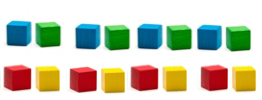This resource explores connections among executive functioning (EF) and patterns and provides tips for early childhood educators to support EF while engaging in patterns.
by Jane Hutchison & Deborah Phillips
EF and Patterns Connections
In the overview module, we discuss why executive functioning (EF) skills are important for early math learning in general (see Overview of Executive Functioning and Math). Here we discuss the role of EF in the domain of patterns (i.e. regularities that we perceive in our environments). Patterns play a big role in children’s early mathematical thinking and likely lay the foundation for more complex math such as algebra. As mentioned in The Mathematics of Pattern and Algebra, four key pattern concepts include; pattern generalization, pattern replication, pattern extension, and pattern creation. Importantly, learning each of these key concepts calls upon executive functioning skills.
- Pattern Generalization: An important concept for children to understand is that the same pattern
 can generalize to different contexts. For example, a simple pattern of ABCABC can appear in sequences of numbers such as 123123 or in sequences of colors such a red-blue-orange-red-blue-orange. The ability to understand that these three sequences are the same even though they contain different stimuli requires cognitive flexibility.
can generalize to different contexts. For example, a simple pattern of ABCABC can appear in sequences of numbers such as 123123 or in sequences of colors such a red-blue-orange-red-blue-orange. The ability to understand that these three sequences are the same even though they contain different stimuli requires cognitive flexibility.
- Pattern Replication: Replicating a pattern that has already been produced (perhaps by a teacher or peer) requires the use of working memory skills. For example, if children are asked to replicate an audio pattern such clap-clap-stomp-clap-clap-stomp, they need to hold the pattern in mind and act on it over a short period of time.
- Pattern Extension: Pattern extension is the continuation of a pattern according to a pre-existing sequence. Similar to pattern replication, the extension of a pattern requires the use of working memory skills. More specifically, in order for children to extend a pattern they must first identify the pattern and then hold that pattern in mind over a short period of time. The role of working memory is particularly pronounced for auditory patterns as the child cannot rely on visuals to remember the pattern.
- Pattern Creation: In addition to replicating and extending existing patterns, preschool children can create their own patterns. Creating a new pattern requires the use of planning and organization skills, as children must first decide what they would like to use (beads, sounds, shapes) and then decide what they would like the pattern to look like.
Ultimately, there are many aspects of patterns in preschool that call upon young children’s executive functioning skills. As such, teachers should think of patterns as an opportunity to support both a key mathematical concept and EF.
Incorporating EF Support into Patterns: Tips for Early Childhood Educators
Below we offer some tips for how early childhood educators can incorporate more explicit opportunities for children to develop their EF skills in activities involving patterns.
Working Memory: Students practice working memory skills when they are required to hold and/or manipulate multiple pieces of information in mind over short periods of time. This information is then used to solve the problem.
- Teachers can support working memory during pattern activities by having students identify, replicate and extend auditory patterns. As previously mentioned, auditory patterns are particularly conducive to working memory support as children must hold the pattern in mind for short periods of time without relying upon visuals. Begin these activities with very simple auditory patterns (such as clap, stomp, clap, stomp) and then build to more complex patterns as children gain these skills.
Inhibitory Control: Students practice inhibitory control skills when they engage in activities that require them to wait their turn and/or think before they act.
- Teachers can support the development of inhibitory control in their students through “repeat after me” pattern activities. For example, the teacher may “wait and watch/listen to what I’m doing and when I’m done I want you to do the same thing.” For example, the teacher may pat each knee twice, then each elbow once, and then the top of her head. In this way, the child is practicing pattern replication while also practicing waiting their turn. Note that this activity also supports working memory as the child has to remember multiple elements of the pattern.
- Teachers can also support inhibitory control by playing games in which the students are only supposed to respond when they receive a specific cue. For example, the teacher may say “if you are wearing blue, clap your hands like this,” followed by “if you are wearing read, clap your hands like this (in a different pattern).” In this way, children are practicing pattern replication while also thinking before they act. Note that this activity also supports working memory as the child has to remember multiple elements of the pattern.
Cognitive Flexibility: Teachers can support cognitive flexibility by encouraging students to make comparisons, shift perspectives and to approach activities in different ways.
- Teachers can support cognitive flexibility during pattern activities by asking students to replicate
 the same pattern using different objects. For example, the teacher might create an AB pattern using red and blue blocks (Red-Blue-Red-Blue) and then ask the student “can you make the same pattern using the circles and squares?” Here, the child has to use their cognitive flexibility skills to figure out how the same pattern applies to different stimuli.
the same pattern using different objects. For example, the teacher might create an AB pattern using red and blue blocks (Red-Blue-Red-Blue) and then ask the student “can you make the same pattern using the circles and squares?” Here, the child has to use their cognitive flexibility skills to figure out how the same pattern applies to different stimuli. - Similarly, teachers can support cognitive flexibility by encouraging students to create a pattern based on one dimension of an object (shape) and then ask them to create a different pattern using a different dimension of the same object (color). In this way, the child realizes that the same object can be classified according to different dimensions while also practicing pattern creation.
Planning and Organization: Students practice their planning and organization skills when they engage in multi-part activities that require the organization of materials and/or adherence to a sequence of steps.
- Teachers can support planning and organization skills by encouraging students to think through the steps of creating a pattern. For example, the teacher may start by saying “what materials would you like to use to create a pattern (such as beads, shapes or colors)?” Next, the teacher might say “what do you want the first part of the pattern to look like?” followed by “how many times do you want to repeat the pattern? How many beads would you need to do that?” In this way, children are planning and organizing their materials before they start creating their pattern.
Check out our Executive Functioning and Math resources across our other content modules:
